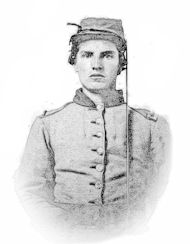Wednesday, 25th.—2 A. M., former and ordered to march out. Federals gained position, and could not be dislodged, consequently the ditches on our left wing are of no benefit. Arrived at top of Missionary Ridge at daylight moving towards right wing. Took our position over the tunnel of the Eastern Tennessee, Virginia and Georgia Railroad, through Missionary Ridge. Level Valley in front, several miles wide and all open; plain view. 9 A. M., Federals advanced in plain view. Our batteries opened fire; 9:15, still advancing. Companies A and F sent to the front as skirmishers; we deployed, and at 9:30 A. M., ordered to fix bayonets and charge. Drove back their advance skirmishers, being uncovered so that Federal batteries enfiladed our line; were ordered to halt; skirmishers’ ammunition about out; still heavy fighting. 10 A. M. second line of Federals advancing across the field in rear of the first. 10:15 A. M-; ordered back to top of hill; 11 A. M., five companies of our regiment thrown forward as skirmishers drove Yanks back from dwelling; ordered to fall back, and did so, but in few moments were ordered to charge and go to the house, which was done, and the house set on fire. Soon after the family made their appearance having been in the cellar, unknown to the officers. We were again ordered back to the top of the hill. Just as we were getting back, Federals charged battery on point just to our right. Col. McConnell ordered regiment up there. 2 P. M. Yanks within thirty yards of battery, but can’t come over; 2:30 P. M., Colonel McConnell shot through the head, mortally wounded. 3 P. M., our regiment and part of Cleaburn’s Division charged Yanks and drove them back in confusion, capturing about two hundred prisoners. I am sent to Chickamauga Station with the prisoners; arrived at 10 P. M., where we learned that Bragg’s left wing and left center was broken and that he had lost nearly all his artillery on that part of the line. Whole army in retreat.

Robert M. Magill—Personal Reminiscences of a Confederate Soldier Boy.
Previous post: Rutherford B. Hayes.
Next post: Three Years in the Confederate Horse Artillery — George Michael Neese.


